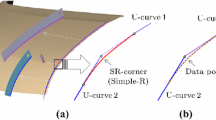Abstract
This paper proposes an efficient reverse engineering technique for compound surfaces using a boundary detection method. This approach consists in extracting geometric edge information using a vision system, which can be used in order to drastically reduce geometric errors in the vicinity of compound surface boundaries. Through the image-processing technique and the interpolation process, boundaries are reconstructed by either analytic curves (e. g. circle, ellipse, line) or parametric curves (B-spline curve). In other regions, except boundaries, geometric data are acquired on CMM as points inspected using a touch type probe, and then they are interpolated on several surfaces using a B-spline skinning method. Finally, the boundary edge and the skinned surfaces are combined to reconstruct the final compound surface. Through simulations and experimental works, the effectiveness of the proposed method is confirmed.
Similar content being viewed by others
Reference
Cho, M.-W. and Seo, T.-I., 1999, “Sculptured Surface Recognition and Localization Strategy in the CMM Process,”International Journal of KSME, Vol. 13, No. 10, pp. 701 -713.
Cho, M. W., Kim, M. K. and Kim, K., 1995, “Flexible Inspection System Based on a Vision Guided Coordinate Measuring Machine,”International Journal of Production Research, Vol. 33, No. 5, pp. 1433–1448.
Duffie, N., Bollinger, J., Piper, R. and Kroneberg, M., 1984, “CAD-Directed Inspection and Error Analysis Using Surface Patch Database,”Annals of the CIRP, Vol. 33, No. 1, pp. 347–350
Faux, I. D. and Pratt, M. J., 1979, “Computational Geometry for Design and Manufacture,”John Wiley and Sons, New York, N. Y.
Gonzalez, Rafael C. and Woods, Richard E., 1992, “Digital Image Processing,” Addison-Wesley Publishing Company.
Medioni, Gerard and Yasumoto, Yoshio, 1987, “Corner Detection and Curve Representation Using Cubic B-Spline,”Computer Vision, Graphics, and Image Processing, Vol. 39, pp. 267–278.
Mortenson, M. E., 1997, “Geometric Modeling,” John Wiley and Sons.
Peng, QingJin and Loftus, Martin, 1998, “A New Approach to Reverse Engineering Based on Vision Information,”International Journal of Machine, Tools and Manufacture, Vol. 38, pp. 881–899,
Piegl, Les and Tiller, Wayne, 1996, “Algorithm for approximation NURBS skinning,”Computer-Aided Design, Vol. 28, No. 9, pp. 699–706.
Piegl, Les and Tiller, Wayne, 1995, “The NURBS Book,” Springer.
Varady, Tamas, Martin, Ralph R. and Cox, Jaordan, 1997, “Reverse Engineering of Geometric Models An Introduction,”Computer-Aided Design, Vol. 29, No. 4, pp. 255–268.
Werner, A. et al., 1997, “Reverse Engineering of Free Form Surfaces,”Journal of Materials Processing Technology, Vol. 76, pp. 182–132.
Woodward, C. D., 1988, “Skinning Techniques for Interactive B-spline Surface Interpolation,”Computer-Aided Design, Vol. 20, No. 8, pp. 441–451.
Yau, Hong-Tzong, 1999, “Reverse Engineering of Engine Intake Ports by Digitization and Surface Approximation,”International Journal of Machine, Tools and Manufacture, Vol. 37, No. 6, pp. 855–871.
Author information
Authors and Affiliations
Corresponding author
Rights and permissions
About this article
Cite this article
Cho, MW., Sea, TI., Kim, JD. et al. Reverse engineering of compound surfaces using boundary detection method. KSME International Journal 14, 1104–1113 (2000). https://doi.org/10.1007/BF03185064
Received:
Revised:
Issue Date:
DOI: https://doi.org/10.1007/BF03185064




